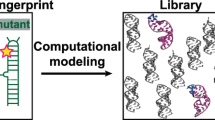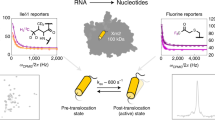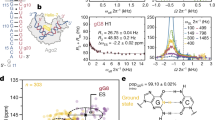Abstract
MicroRNAs are evolutionarily conserved small, noncoding RNAs that regulate diverse biological processes. Due to their essential regulatory roles, microRNA biogenesis is tightly regulated, where protein factors are often found to interact with specific primary and precursor microRNAs for regulation. Here, using NMR relaxation dispersion spectroscopy and mutagenesis, we reveal that the precursor of oncogenic microRNA-21 exists as a pH-dependent ensemble that spontaneously reshuffles the secondary structure of the entire apical stem-loop region, including the Dicer cleavage site. We show that the alternative excited conformation transiently sequesters the bulged adenine into a noncanonical protonated A+-G mismatch, conferring a substantial enhancement in Dicer processing over its ground conformational state. These results indicate that microRNA maturation efficiency may be encoded in the intrinsic dynamic ensemble of primary and precursor microRNAs, providing a potential means of regulating microRNA biogenesis in response to environmental and cellular stimuli.

This is a preview of subscription content, access via your institution
Access options
Access Nature and 54 other Nature Portfolio journals
Get Nature+, our best-value online-access subscription
$29.99 / 30 days
cancel any time
Subscribe to this journal
Receive 12 print issues and online access
$259.00 per year
only $21.58 per issue
Buy this article
- Purchase on Springer Link
- Instant access to full article PDF
Prices may be subject to local taxes which are calculated during checkout






Similar content being viewed by others
Data availability
All data supporting the findings of this study are available in this published article, extended data and source data files.
Code availability
The in-house OriginLab scripts for data analyses are available upon request.
References
Friedman, R. C., Farh, K. K., Burge, C. B. & Bartel, D. P. Most mammalian mRNAs are conserved targets of microRNAs. Genome Res. 19, 92–105 (2009).
Siomi, H. & Siomi, M. C. Posttranscriptional regulation of microRNA biogenesis in animals. Mol. Cell 38, 323–332 (2010).
Ha, M. & Kim, V. N. Regulation of microRNA biogenesis. Nat. Rev. Mol. Cell Biol. 15, 509–524 (2014).
Gebert, L. F. R. & MacRae, I. J. Regulation of microRNA function in animals. Nat. Rev. Mol. Cell Biol. 20, 21–37 (2019).
Treiber, T., Treiber, N. & Meister, G. Regulation of microRNA biogenesis and its crosstalk with other cellular pathways. Nat. Rev. Mol. Cell Biol. 20, 5–20 (2019).
Esteller, M. Non-coding RNAs in human disease. Nat. Rev. Genet. 12, 861–874 (2011).
Lin, S. & Gregory, R. I. MicroRNA biogenesis pathways in cancer. Nat. Rev. Cancer 15, 321–333 (2015).
Zhang, X. & Zeng, Y. The terminal loop region controls microRNA processing by Drosha and Dicer. Nucleic Acids Res. 38, 7689–7697 (2010).
Tsutsumi, A., Kawamata, T., Izumi, N., Seitz, H. & Tomari, Y. Recognition of the pre-miRNA structure by Drosophila Dicer-1. Nat. Struct. Mol. Biol. 18, 1153–1158 (2011).
Castilla-Llorente, V., Nicastro, G. & Ramos, A. Terminal loop-mediated regulation of miRNA biogenesis: selectivity and mechanisms. Biochem. Soc. Trans. 41, 861–865 (2013).
Auyeung, V. C., Ulitsky, I., McGeary, S. E. & Bartel, D. P. Beyond secondary structure: primary-sequence determinants license pri-miRNA hairpins for processing. Cell 152, 844–858 (2013).
Nguyen, T. A., Park, J., Dang, T. L., Choi, Y. G. & Kim, V. N. Microprocessor depends on hemin to recognize the apical loop of primary microRNA. Nucleic Acids Res. 46, 5726–5736 (2018).
Gu, S. et al. The loop position of shRNAs and pre-miRNAs is critical for the accuracy of dicer processing in vivo. Cell 151, 900–911 (2012).
Contrant, M. et al. Importance of the RNA secondary structure for the relative accumulation of clustered viral microRNAs. Nucleic Acids Res. 42, 7981–7996 (2014).
van Kouwenhove, M., Kedde, M. & Agami, R. MicroRNA regulation by RNA-binding proteins and its implications for cancer. Nat. Rev. Cancer 11, 644–656 (2011).
Liu, Z., Wang, J., Li, G. & Wang, H. W. Structure of precursor microRNA’s terminal loop regulates human Dicer’s dicing activity by switching DExH/D domain. Protein Cell 6, 185–193 (2015).
Pandolfini, L. et al. METTL1 promotes let-7 microRNA processing via m7G methylation. Mol. Cell 74, 1278–1290 (2019).
Dallaire, P. et al. Structural dynamics control the microRNA maturation pathway. Nucleic Acids Res. 44, 9956–9964 (2016).
Iki, T. et al. Structural flexibility enables alternative maturation, ARGONAUTE sorting and activities of miR168, a global gene silencing regulator in plants. Mol. Plant 11, 1008–1023 (2018).
Ganser, L. R., Kelly, M. L., Herschlag, D. & Al-Hashimi, H. M. The roles of structural dynamics in the cellular functions of RNAs. Nat. Rev. Mol. Cell Biol. 20, 474–489 (2019).
Zeng, Y. & Cullen, B. R. Sequence requirements for micro RNA processing and function in human cells. RNA 9, 112–123 (2003).
Volinia, S. et al. A microRNA expression signature of human solid tumors defines cancer gene targets. Proc. Natl Acad. Sci. USA 103, 2257–2261 (2006).
Kumarswamy, R., Volkmann, I. & Thum, T. Regulation and function of miRNA-21 in health and disease. RNA Biol. 8, 706–713 (2011).
Zeng, Y., Yi, R. & Cullen, B. R. Recognition and cleavage of primary microRNA precursors by the nuclear processing enzyme Drosha. EMBO J. 24, 138–148 (2005).
Trabucchi, M. et al. The RNA-binding protein KSRP promotes the biogenesis of a subset of microRNAs. Nature 459, 1010–1014 (2009).
Chirayil, S., Wu, Q., Amezcua, C. & Luebke, K. J. NMR characterization of an oligonucleotide model of the miR-21 pre-element. PLoS ONE 9, e108231 (2014).
Shortridge, M. D. et al. A macrocyclic peptide ligand binds the oncogenic microRNA-21 precursor and suppresses Dicer processing. ACS Chem. Biol. 12, 1611–1620 (2017).
Massi, F., Johnson, E., Wang, C., Rance, M. & Palmer, A. G. 3rd NMR R1rho rotating-frame relaxation with weak radio frequency fields. J. Am. Chem. Soc. 126, 2247–2256 (2004).
Korzhnev, D. M., Orekhov, V. Y. & Kay, L. E. Off-resonance R1ρ NMR studies of exchange dynamics in proteins with low spin-lock fields: an application to a Fyn SH3 domain. J. Am. Chem. Soc. 127, 713–721 (2005).
Hansen, A. L., Nikolova, E. N., Casiano-Negroni, A. & Al-Hashimi, H. M. Extending the range of microsecond-to-millisecond chemical exchange detected in labeled and unlabeled nucleic acids by selective carbon R1ρ NMR spectroscopy. J. Am. Chem. Soc. 131, 3818–3819 (2009).
Sekhar, A. & Kay, L. E. NMR paves the way for atomic level descriptions of sparsely populated, transiently formed biomolecular conformers. Proc. Natl Acad. Sci. USA 110, 12867–12874 (2013).
Palmer, A. G. 3rd Chemical exchange in biomacromolecules: past, present, and future. J. Magn. Reson. 241, 3–17 (2014).
Houck-Loomis, B. et al. An equilibrium-dependent retroviral mRNA switch regulates translational recoding. Nature 480, 561–564 (2011).
Chu, C. C., Plangger, R., Kreutz, C. & Al-Hashimi, H. M. Dynamic ensemble of HIV-1 RRE stem IIB reveals non-native conformations that disrupt the Rev-binding site. Nucleic Acids Res. 47, 7105–7117 (2019).
Zhao, B., Baisden, J. T. & Zhang, Q. Probing excited conformational states of nucleic acids by nitrogen CEST NMR spectroscopy. J. Magn. Reson. 310, 106642 (2020).
Thaplyal, P. & Bevilacqua, P. C. Experimental approaches for measuring pKa’s in RNA and DNA. Methods Enzymol. 549, 189–219 (2014).
Dethoff, E. A., Petzold, K., Chugh, J., Casiano-Negroni, A. & Al-Hashimi, H. M. Visualizing transient low-populated structures of RNA. Nature 491, 724–728 (2012).
Lee, J., Dethoff, E. A. & Al-Hashimi, H. M. Invisible RNA state dynamically couples distant motifs. Proc. Natl Acad. Sci. USA 111, 9485–9490 (2014).
Parisien, M. & Major, F. The MC-Fold and MC-Sym pipeline infers RNA structure from sequence data. Nature 452, 51–55 (2008).
Pan, B., Mitra, S. N. & Sundaralingam, M. Crystal structure of an RNA 16-mer duplex R(GCAGAGUUAAAUCUGC)2 with nonadjacent G(syn)·A+(anti) mispairs. Biochemistry 38, 2826–2831 (1999).
Leonard, G. A. et al. Crystal and molecular structure of r(CGCGAAUUAGCG): an RNA duplex containing two G(anti)·A(anti) base pairs. Structure 2, 483–494 (1994).
Lee, H. Y. & Doudna, J. A. TRBP alters human precursor microRNA processing in vitro. RNA 18, 2012–2019 (2012).
Zhang, H., Kolb, F. A., Brondani, V., Billy, E. & Filipowicz, W. Human Dicer preferentially cleaves dsRNAs at their termini without a requirement for ATP. EMBO J. 21, 5875–5885 (2002).
Muth, G. W., Ortoleva-Donnelly, L. & Strobel, S. A. A single adenosine with a neutral pKa in the ribosomal peptidyl transferase center. Science 289, 947–950 (2000).
Nam, Y., Chen, C., Gregory, R. I., Chou, J. J. & Sliz, P. Molecular basis for interaction of let-7 microRNAs with Lin28. Cell 147, 1080–1091 (2011).
Zhao, B., Hansen, A. L. & Zhang, Q. Characterizing slow chemical exchange in nucleic acids by carbon CEST and low spin-lock field R1ρ NMR spectroscopy. J. Am. Chem. Soc. 136, 20–23 (2014).
Delaglio, F. et al. NMRpipe: a multidimensional spectral processing system based on UNIX pipes. J. Biomol. NMR 6, 277–293 (1995).
Johnson, B. A. & Blevins, R. A. NMRView: a computer program for the visualization and analysis of NMR data. J. Biomol. NMR 4, 603–614 (1994).
Zhao, B., Guffy, S. L., Williams, B. & Zhang, Q. An excited state underlies gene regulation of a transcriptional riboswitch. Nat. Chem. Biol. 13, 968–974 (2017).
Kuhlman, B., Luisi, D. L., Young, P. & Raleigh, D. P. pKa values and the pH dependent stability of the N-terminal domain of L9 as probes of electrostatic interactions in the denatured state. Differentiation between local and nonlocal interactions. Biochemistry 38, 4896–4903 (1999).
Guenneugues, M., Berthault, P. & Desvaux, H. A method for determining B1 field inhomogeneity. Are the biases assumed in heteronuclear relaxation experiments usually underestimated? J. Magn. Reson. 136, 118–126 (1999).
Vallurupalli, P., Bouvignies, G. & Kay, L. E. Studying “invisible” excited protein states in slow exchange with a major state conformation. J. Am. Chem. Soc. 134, 8148–8161 (2012).
Mcconnell, H. M. Reaction rates by nuclear magnetic resonance. J. Chem. Phys. 28, 430–431 (1958).
Allard, P., Helgstrand, M. & Hard, T. The complete homogeneous master equation for a heteronuclear two-spin system in the basis of cartesian product operators. J. Magn. Reson. 134, 7–16 (1998).
Helgstrand, M., Hard, T. & Allard, P. Simulations of NMR pulse sequences during equilibrium and non-equilibrium chemical exchange. J. Biomol. NMR 18, 49–63 (2000).
Hansen, A. L. & Kay, L. E. Measurement of histidine pKa values and tautomer populations in invisible protein states. Proc. Natl Acad. Sci. USA 111, E1705–E1712 (2014).
Sekhar, A., Rosenzweig, R., Bouvignies, G. & Kay, L. E. Hsp70 biases the folding pathways of client proteins. Proc. Natl Acad. Sci. USA 113, E2794–E2801 (2016).
Kolb, F. A. et al. Human dicer: purification, properties, and interaction with PAZ PIWI domain proteins. Methods Enzymol. 392, 316–336 (2005).
DiNitto, J. P., Wang, L. & Wu, J. C. Continuous fluorescence-based method for assessing dicer cleavage efficiency reveals 3′ overhang nucleotide preference. BioTechniques 48, 303–311 (2010).
Zuker, M. Mfold web server for nucleic acid folding and hybridization prediction. Nucleic Acids Res. 31, 3406–3415 (2003).
Acknowledgements
We thank G. Young and S. Parnham for maintenance of NMR instruments and members of the Zhang laboratory for critical comments. This work was supported by a start-up fund and Jefferson Pilot Fellowship from the University of North Carolina at Chapel Hill and an NSF grant (MCB1652676).
Author information
Authors and Affiliations
Contributions
J.T.B. and Q.Z. conceived the project and experimental design. J.T.B., J.A.B., B.Z., S.M.H. and Q.Z. prepared the samples. J.T.B., J.A.B., B.Z. and Q.Z. carried out NMR experiments, analyzed the data and wrote the paper.
Corresponding author
Ethics declarations
Competing interests
The authors declare no competing interests.
Additional information
Publisher’s note Springer Nature remains neutral with regard to jurisdictional claims in published maps and institutional affiliations.
Extended data
Extended Data Fig. 1 13C R1ρ RD profiles of preE-miR-21 residues without apparent chemical exchange.
On- and off-resonance 13C RD profiles depicting spin-lock power (ωeff/2π) and offset (Ω/2π) dependence of R2 + Rex measured at pH 6.45. Solid lines represent the best fits to a single-state model using the Bloch-McConnell equation. Shown are best-fit values and experimental uncertainties (s.d.) estimated from mono-exponential fitting of n = 3 independently measured peak intensities.
Extended Data Fig. 2 13C R1ρ RD profiles of preE-miR-21 residues that undergo chemical exchange at pH 6.45.
Solid lines represent the best fits to a global two-state exchange model (kex = 1445 ± 17 s−1 and pE = 15.2 ± 0.3%) using the Bloch-McConnell equation. Shown are best-fit values and experimental uncertainties (s.d.) estimated from mono-exponential fitting of n = 3 independently measured peak intensities.
Extended Data Fig. 3 Comparison of GS, ES, mutant carbon chemical shifts.
Shown are differences between the observed chemical shifts (black) and the chemical shifts of GS (blue) and ES (red) extracted from 13 C R1ρ RD profiles at pH 6.45, G38U mutant at pH 6.45, and preE-miR-21 at pH 4.81. The apparent discrepancies between ES base carbon chemical shifts of A-C2/C8s and C-C5/C6s and their corresponding chemical shifts at pH 4.81 are likely due to intrinsic protonation at A-N1s and C-N3s at pH 4.81.
Extended Data Fig. 4 13C R1ρ RD characterization of preE-miR-21 at pH 8.04.
a, On- and off-resonance 13C RD profiles of residues that are exchange-broadened at lower pH points, including A22-C2, G38-C8, and G38-C1’. Solid lines represent the best fits to a global two-state exchange (kex = 1228 ± 51 s−1 and pE = 1.1 ± 0.1%) using the Bloch-McConnell equation. b, Comparison of GS, ES, mutant carbon chemical shifts. Shown are differences between observed chemical shifts (black) and chemical shifts of GS (blue) and ES (red) extracted from 13C R1ρ RD profiles at pH 8.04, G38U mutant at pH 6.45, and preE-miR-21 at pH 4.81. Shown are best-fit values and experimental uncertainties (s.d.) estimated from mono-exponential fitting of n = 3 independently measured peak intensities.
Extended Data Fig. 5 NMR RD characterization of pH-dependent chemical exchange of residue A22.
Shown are 13C R1ρ RD profiles of A22-C2/C8/C1’ and 15N CEST profile of A22-N1 at a-b, pH 8.04, c-d, pH 7.47, and e-f, pH 6.96. Solid lines represent the best fits to a global two-state exchange model at each individual pH condition using the Bloch-McConnell equation, resulting in pE = 1.1 ± 0.1% at pH 8.04, pE = 3.4 ± 0.1% at pH 7.47, and pE = 6.4 ± 0.1% at pH 6.96. Shown are best-fit values and experimental uncertainties (s.d.) estimated from n = 3 independently measured peak intensities for CEST profiles and mono-exponential fitting of n = 3 independently measured peak intensities for R1ρ RD profiles.
Extended Data Fig. 6 NMR characterization of pH-dependent changes of preE-miR-21.
a, 13C-1H HSQC spectra of base carbons (C6 and C8) of uniformly 13C/15N-labeled preE-miR-21 at pHs 4.35 and 8.04 with mapping of chemical shift changes. b, 13C-1H HSQC spectra of base carbons (C8) of adenine-specifically 13C/15N-labeled preE-miR-21 with pH ranging from 4.35 to 8.04. c, 13C-1H HSQC spectra of base carbons (C2) of adenine-specifically 13C/15N-labeled preE-miR-21 with pH ranging from 4.35 to 8.04.
Extended Data Fig. 7 NMR characterization of preE-miR-21 mutants.
Shown are 13C-1H HSQC spectra of base carbons (C6 and C8) (black) that overlay with 13C-1H HSQC spectrum of WT preE-miR-21 at pH 8.04 (green) at 35oC, 1H-1H imino NOESY and 15N-1H HSQC spectra at 10oC, and 13C R1ρ RD profiles of uniformly 13C/15N-labeled a, ∆A22 “bulge”, b, GC “Stem”, and c, UUCG “Loop” mutants at pH 6.45. Solid lines represent the best fits to a single-state model using the Bloch-McConnell equation. Shown are best-fit values and experimental uncertainties (s.d.) estimated from mono-exponential fitting of n = 3 independently measured peak intensities.
Extended Data Fig. 8 Secondary structure prediction of preE-miR-21 and G38U mutant by Mfold and MC-Fold.
a, M-fold predicted secondary structure of preE-miR-21, which contains G-U base pairs as observed in NMR data of the ground state. b, MC-Fold predicted secondary structures of preE-miR-21. Shown are the top 5 lowest-energy structures, ranked with ∆G relative to the lowest predicted structure. The A22-G38 base pair is predicted in all MC-Fold structures. c, M-fold predicted secondary structure of preE-miR-21 G38U mutant. d, MC-Fold predicted secondary structures of preE-miR-21 G38U mutant. Shown are the top 5 lowest-energy structures, ranked with ∆G relative to the lowest predicted structure. Both M-fold and MC-Fold predict the same lower stem structure of preE-miR-21 G38U mutant, which is also consistent with NMR data.
Extended Data Fig. 9 NMR characterization of preE-miR-21 excited-state mimic.
Shown are a, 13C-1H HSQC spectrum of base carbons (C6 and C8) (black) that overlays with 13C-1H HSQC spectrum of WT preE-miR-21 at pH 8.04 (green) at 35oC, b, 1H-1H imino NOESY at 75 ms mixing time and 15N-1H HSQC spectra at 10oC, and c, 13C R1ρ RD profiles of uniformly 13C/15N-labeled G38U mutant at pH 6.45. Solid lines represent the best fits to a single-state model using the Bloch-McConnell equation. Shown are best-fit values and experimental uncertainties (s.d.) estimated from mono-exponential fitting of n = 3 independently measured peak intensities.
Extended Data Fig. 10 Single-turnover pre-miR-21 processing with 10-fold, 25-fold, and 250-fold excess Dicer enzyme.
a, Single-turnover processing assays of recombinant human Dicer (500 nM) with pre-miR-21 at 50, 20, and 2 nM concentrations at pH 7.77 and 35 °C. b, Quantification of time-dependent Dicer processing of wild-type pre-miR-21 using ImageQuant. Solid lines represent best fits to a single exponential equation as described in Methods. Shown are mean values and standard deviations (s.d.) from n = 3 independent assays.
Supplementary information
Source data
Source Data Fig. 5b–d
Full-length, unprocessed gel images.
Source Data Fig. 5e–g
Statistical source data: Dicer processing assay.
Source Data Extended Data Fig. 10a
Full-length, unprocessed gel images.
Source Data Extended Data Fig. 10b
Statistical source data: Dicer processing assay.
Rights and permissions
About this article
Cite this article
Baisden, J.T., Boyer, J.A., Zhao, B. et al. Visualizing a protonated RNA state that modulates microRNA-21 maturation. Nat Chem Biol 17, 80–88 (2021). https://doi.org/10.1038/s41589-020-00667-5
Received:
Revised:
Accepted:
Published:
Issue Date:
DOI: https://doi.org/10.1038/s41589-020-00667-5
This article is cited by
-
A conserved SNP variation in the pre-miR396c flanking region in Oryza sativa indica landraces correlates with mature miRNA abundance
Scientific Reports (2023)
-
Dynamic basis for dA•dGTP and dA•d8OGTP misincorporation via Hoogsteen base pairs
Nature Chemical Biology (2023)
-
Rational design of hairpin RNA excited states reveals multi-step transitions
Nature Communications (2022)
-
Mutate-and-chemical-shift-fingerprint (MCSF) to characterize excited states in RNA using NMR spectroscopy
Nature Protocols (2021)



